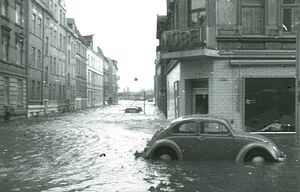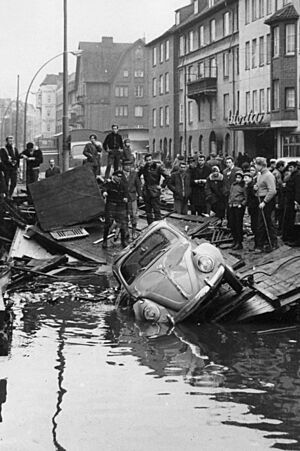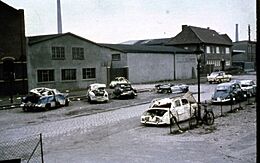North Sea flood of 1962 facts for kids

Flooded streets in Hamburg-Wilhelmsburg
|
|
| Meteorological history | |
|---|---|
| Duration | 16–17 February 1962 |
| Overall effects | |
| Fatalities | 347 |
| Damage | DM 3 billion (Hamburg only) |
| Areas affected | North Sea coast of Germany and the Netherlands |
The North Sea flood of 1962 was a huge natural disaster that hit the coast of West Germany, especially the city of Hamburg. It happened during the night of February 16-17, 1962. About 60,000 people lost their homes. Sadly, 315 people died in Hamburg alone. A very strong storm, called an extratropical cyclone, caused this flood. This storm had already crossed the United Kingdom as the Great Sheffield Gale, causing damage in Sheffield and killing nine people there.
Contents
What Caused the 1962 North Sea Flood?
The flood was caused by a low-pressure system named Vincinette. This system is better known as the Great Sheffield Gale. It came from the southern Polar Sea and moved towards the German Bight. A powerful European windstorm with winds up to 200 kilometers per hour (about 124 miles per hour) pushed a lot of water into the German Bight.
This huge amount of water caused a surge that the dykes (protective walls) could not hold back. Many dykes along the coast and the rivers Elbe and Weser broke. This led to widespread flooding in large areas. In Hamburg, which is on the river Elbe about 100 kilometers (62 miles) from the coast, the neighborhoods of Wilhelmsburg were hit the hardest.
On Thursday, February 15, German officials issued the first storm warning for the North Sea. They predicted wind speeds up to 9 Beaufort. The next day, a severe storm warning followed. It predicted the water level would be 3 meters (about 10 feet) above normal. This was a level the dykes were expected to handle.
How the Storm Unfolded
The severe storm and the flood it caused on February 16 were much worse than predicted. About 50 dykes broke before officials could even warn Hamburg. At that time of day, most city offices were closed. This made it harder to quickly tell people about the danger. Also, plans for civil protection were not yet fully in place.
Telephone lines broke down, so warnings could not be sent from coastal emergency offices to inland ones. Alarm sirens and electricity lines also failed. This severely affected the warning system. Radio amateurs had to set up emergency communication systems to help the rescue services.
Around midnight, the water peaks were too high for some dykes. The backs of the dykes were not strong enough. So, when water went over the top, it destroyed the dykes from behind. This opened the way for the floodwaters to rush in.
Rescue Efforts and Help from Helmut Schmidt
Helmut Schmidt, who was the police senator (a high-ranking official) of Hamburg at the time, took charge of the rescue operations. He asked for emergency help from countries across Western Europe. He also called on the Bundeswehr (Germany's armed forces) to assist, especially their engineers. This meant he went beyond his normal legal powers. The German constitution usually did not allow the army to be used for "internal affairs" like disasters. A special rule for disasters was only added later in 1968.
Schmidt also got help from helicopters from other NATO countries. People called these helicopters Fliegende Engel, which means "Flying Angels."
The flood covered 120 square kilometers (about 46 square miles) of Hamburg. This was about one-sixth of the entire city. About 6,000 buildings were destroyed. Streets became unusable, and railway services stopped. This meant that supplies could not reach the city.
What Happened After the Flood?
After the flood, Greece donated 500 tonnes of raisins to the people of Hamburg. Following this disaster, new emergency plans were put into action. Dykes were made shorter and much stronger. Some river arms and bays were even cut off from the sea to prevent future floods.
See Also
- History of Hamburg
- North Sea flood of 1953
- Storm tides of the North Sea
- List of floods in Europe
- List of deadliest floods




